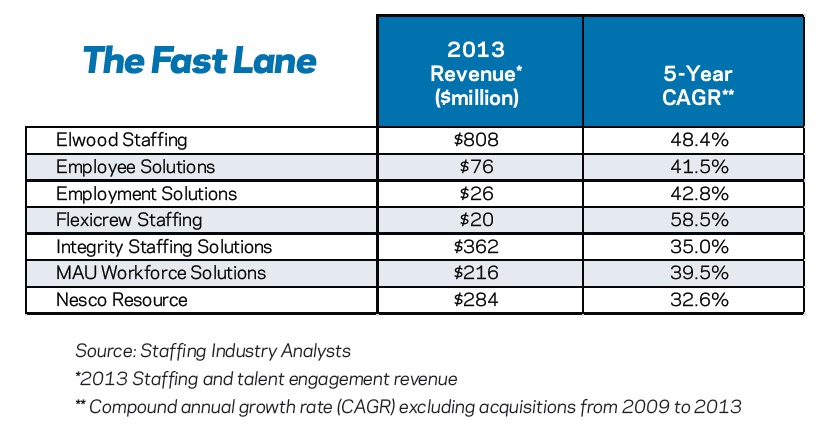CEOs of fastest-growing industrial staffing firms reveal their strategies
In today’s ultra-competitive staffing industry, staffing firms that want to flourish need successful strategies and tactics. With demands from clients ever increasing, price competition intense, and rapid changes in technology and legislation swirling, staffing firms cannot expect to succeed by simply hoping to have a lucky year or to benefit from a rising economic tide that will lift all boats. No, staffing firms must differentiate themselves with winning strategies.
To learn about strategies that have succeeded in today’s marketplace, we interviewed the CEOs of seven industrial staffing firms that ranked near the top in our report, “2014 Fastest- Growing Staffing and Talent Engagement Firms in the US.” Combined, these firms achieved stellar organic compound annual revenue growth of 43% from 2009 to 2013, compared with 13% annual growth in the overall industrial staffing segment. And while their success stories were achieved in the context of industrial staffing, much of their advice is relevant to the broader US staffing industry.
Three key ingredients to a successful staffing strategy that emerged as common themes during our interviews are focusing on internal staff, investing strategically based on geography, and leveraging the economic cycle.
Internal Staff
The most cited factor that enabled outsized revenue growth was a focus on internal staff, according to these CEOs.
“Our real difference is the quality of our internal employee base. We invest heavily in training our internal team via weekly and monthly internal trainings,” says Bill Brennan, CEO of Mobile, Ala.-based Flexicrew Staffing. “In turn, the training drives excellent client relationships and service. Our investment in training has helped us grow and also helps us attract good employees.”
The value of employee training is also cited by David Bristol, CEO of Plano, Texas-based Employee Solutions: “Consistent with our core values, all of our internal staff hold a Certified Staffing Professional (CSP) certification — recruiting, sales, even our safety people.”
Promotion of internal staff to take on new responsibilities was cited as a direct driver of revenue growth by Mark Elwood, CEO of Columbus, Ind.-based Elwood Staffing, “If I have a fantastic manager and salesperson in a particular branch, who are capable of opening up a second branch office in that city 30 or 45 minutes away, I can capitalize on their strengths by giving them increased responsibility. That is an example of how we have grown with our employees.”
Investing Strategically Based on Geography
Strategic decisions regarding geography were cited as a top factor for achieving revenue growth.
“We have benefited from our location in the Texas, Oklahoma and Arkansas areas, which have been economic hotspots compared to other areas in the country,” says Bristol. “We have been very strategic in our decision to be in the right spot economically as we decide where to grow.”
Timothy McPherson, president of Cleveland, Ohio-based Nesco Resource describes success in finding new areas of demand, “We have grown by looking outside of the larger metro markets and identifying opportunities in smaller cities where there are no staffing firms, or at least not one with the level of service that we can provide as a national firm. Sometimes these opportunities have arisen when we have learned about new manufacturing plants being built in these locations.”
Todd Bavol, CEO of Wilmington, Delaware-based Integrity Staffing Solutions, describes winning new business as a result of close customer knowledge and advance planning, “Our close relationships with our clients allowed us to be aligned with their growth forecasts, so that when their demand increased we were ready and already had the infrastructure in place. We were able to be proactive rather than reactive.”
Leveraging the Economic Cycle
Awareness of the business cycle and a longer-term strategic view was a driver of growth and competitive advantage, according to two firms. In a some- what surprising finding, actions taken during the last recession proved critical in producing revenue growth as the economy recovered.
“During the last recession, we did not reduce our spending on sales, marketing and client acquisition,” says Bavol. “We actually increased it slightly. We had done this during the recession before the last recession and it worked, and that helped us choose to do it again. To explain further, during the recession we invested in our sales teams and rather than have them focus on client acquisition, we had them focus on client retention and making preparations for the upturn.”
A similar achievement was shared by Rick Wagner, CEO of Fort Collins, Colorado-based Employment Solutions, “During the downturn in 2009, we didn’t cut any of our sales personnel and even added one, while most of our competitors reduced their salesforce. This was one factor that enabled our revenue growth.”
Other Factors Credited
In addition to these, there were a number of other tactics and strategies that firms cited as critical to their success. Examples include tactics for achieving high levels of customer service, building special capabilities to serve large clients, and developing competitive advantages in key functions such as recruiting and promoting worker safety. Full details can be found in the report, “Insights from Fast-Growing Industrial Staffing Firms.”








